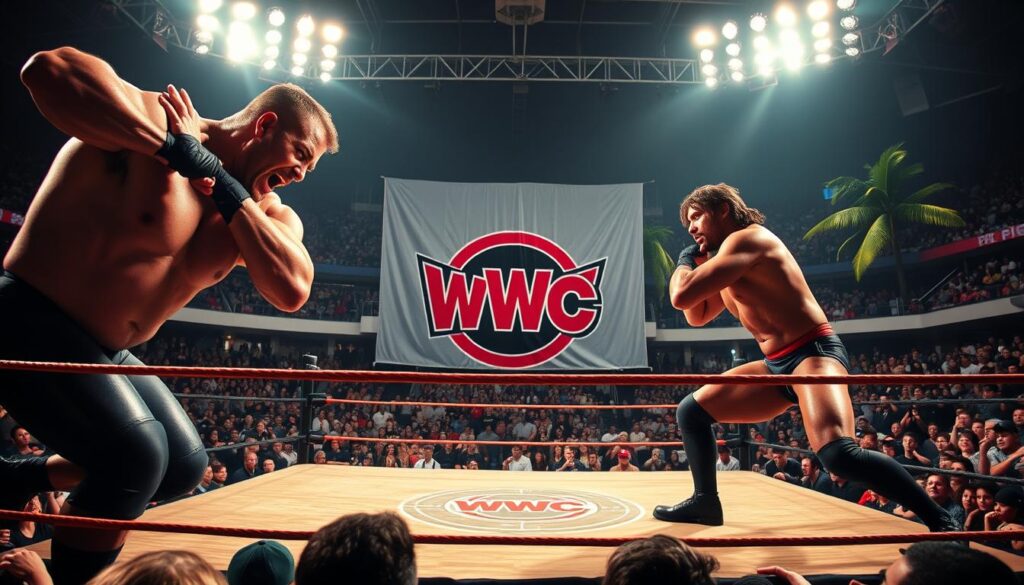Imagine a sweaty coliseum where telenovela drama meets wrestling. Fans cheer more for the drama than the wins. Welcome to WWC, Puerto Rico’s twist on Shakespeare. It started as Capital Sports Promotions in 1973 and became a unique spectacle.
Puerto Rico’s wrestling fans don’t just watch – they live it. They analyze storylines like they’re studying literature. The infamous 1988 “vomit-blood” incident is a topic of debate. Wrestlers are seen as heroes in a never-ending drama, where pride and honor are at stake.
What makes WWC special? It’s the intense Monday Night WarZone events and the brief but powerful G-Fed alliance. It shows wrestling isn’t just a show in Puerto Rico. It reflects the island’s passions, rivalries, and love for drama.
Founding and Evolution
The World Wrestling Council started in 1973 with Carlos Colón’s big move. It was like a spark that lit a fire in the Caribbean. What was once a simple sports promotion became the World Wrestling Council. It changed the face of wrestling with its bold moves and broken alliances.
Key Historical Highlights
WWC’s story is filled with brutal poetry in the ring and backstage Shakespearean drama. The 1988 Brody murder was a turning point. It showed the dark side of wrestling politics.
Savio Vega’s rise in the 1990s was a key moment. His career was marked by powerful moves and a mix of styles. The 1990 mud match between TNT and Colón was more than just a fight. It was a commentary on politics.
| Year | Event | Impact |
|---|---|---|
| 1973 | Colón founds Capital Sports | Creates Caribbean wrestling hub |
| 1988 | Brody incident | Redefined backstage security protocols |
| 1990 | TNT vs Colón mud match | Peak cultural/political crossover |
| 1995 | Savio Vega’s breakout | Fused Japanese/Puerto Rican styles |
WWC’s matches were like the final episodes of telenovelas. Every move had a deep meaning. The promotion was more than wrestling. It was a way to tell stories and change the world through sports.
WWC’s Contribution to Wrestling World
While American fans cheered “Hulk Rules,” Puerto Rico’s wrestling scene created a different kind of art. It was made of blood, sweat, and a bit of questionable ethics. The World Wrestling Council didn’t just host matches; they staged visceral performances that would make Tarantino blush.
The 1988 “Chest Cavity Concerto” between Carlos Colón and Invader 3 was a spectacle. It raised questions about whether it was a worked match, performance art, or even orthopedic malpractice. The knee drops alone sparked more conspiracy theories than the Zapruder film. Surgeons confirmed the cartilage damage was real, yet the crowd’s enthusiasm was just as intense.
Savio Vega’s Cobra Clutch made him a boogeyman in Puerto Rico. His TNT Championship reign was not just dominant; it was a form of psychological warfare set to salsa. Japanese promoters study Vega’s ability to control crowds like a heavy metal conductor with a steel chair.
What made these WWC Puerto Rico spectacles last? They mixed athleticism with absurdity. While Vince McMahon sold action figures, WWC sold out stadiums with stories where heroes and villains blurred quickly, like a luchador’s mask swap.
The Business Side of WWC
While Vince McMahon was building global empires, Puerto Rico’s wrestling scene was doing something special. They turned simple fights into a money-making machine. 20,000 screaming fans paid to see “athletes” fight with everyday objects.
The secret was a mix of Game of Thrones and street vendor smarts. WWE spent big on pyro, but this group used resourceful storytelling. A blood packet was cheap, and a well-placed blade job was priceless.
They were masters of making TV magic happen. Their crews taped events like ninjas, capturing every moment. This way, they made the most of their budget.
Their success was clear. They sold out stadiums, even as others failed. Why? Cultural calculus was their game. They turned rivalries into island-wide passions. When others tried to expand, they found fans ready for authentic chaos.
This wasn’t just smart business. It was a form of economic warfare. While ECW went bankrupt, Puerto Rico’s wrestlers built lasting empires. The key? Sometimes, the best plan is to throw someone through a flaming table.
Analyzing WWC’s Influence and Legacy
What does a wrestling promotion leave behind when the gold fades? Not just trophies, but cultural DNA. This is seen in AEW’s barbed wire shows and Mexico’s lucha de apuestas. Their true legacy is in emergency rooms and bars, where lines blur between show and real life.
Bruiser Brody’s spirit haunts locker rooms, not with Undertaker’s flair but with wild energy. His style started modern hardcore wrestling. Yet, his true mark is in shows that ask: “How much pain can an audience stomach before it becomes poetry?”
Connections stretch across the globe. Invader 3’s broken mask echoes Pentagon Jr’s bone-crushing moves. As the promotion celebrates its 50th year, we ponder wrestling’s violent metaphors. Do they help us understand reality, or become our new sickness? Their answer? A Puerto Rican saying: “Keep the blade handy.”
Survival Tactics for Wrestling’s Last Rebel Territory
WWC Puerto Rico faces a big challenge in 2023. Savio Vega’s return to WWE shows the power of nostalgia. But, new fans want something more than just famous matches with blood and cinderblocks.
The promotion that made backstage fights part of the show now battles on three fronts. WWE’s celebrity appearances, IWA’s grassroots efforts, and fans looking for TikTok-worthy moments all compete for attention.
Can Carlos Colon’s legacy be saved through new storytelling? Imagine combining Lucha Underground’s aerial stunts with the historical drama of Hamilton. Or picture VR broadcasts where fans dodge virtual chairs during Street Fights.
AEW’s Forbidden Door might open for talent swaps, letting WWC’s hardcore stars teach Darby Allin new pain-embracing techniques.
The real challenge is to grow without losing what made WWC special. Famous matches can’t be replaced, but augmented reality could make fans feel every hit. When Bad Bunny headlines WWE’s Puerto Rican event, WWC responds with local reggaeton stars writing entrance themes.
History shows WWC Puerto Rico is like cockroaches in a nuclear winter – it won’t go away. This promotion turned vomit into drama and made fans cheer for traffic cones. As wrestling gets broken up by streaming, WWC’s survival might depend on becoming the go-to for chaos with context.
One thing’s for sure: anyone expecting WWC to retire quietly hasn’t seen Carlito spit apple slices at fate.


